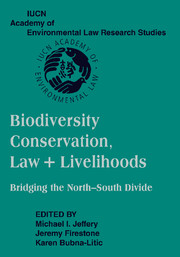 Biodiversity Conservation, Law and Livelihoods: Bridging the North-South Divide
Biodiversity Conservation, Law and Livelihoods: Bridging the North-South Divide Published online by Cambridge University Press: 31 July 2009
INTRODUCTION
Consistent with international obligations, marine biodiversity protection in Australia is achieved primarily through the establishment of protected areas or sanctuaries, the sustainable management of fisheries and the protection of indigenous and endangered marine species. Australia historically has had a multiplicity of legislative regimes at a federal and state level that addressed the protection the marine environment. However, in recent years, with the adoption of Australia's Oceans Policy in 1998 and the passing of the Environment Protection and Biodiversity Conservation Act 1999 (C'th) (EPBC Act), the federal and state governments have begun to develop complementary management approaches for marine ecosystems and to put in place strong legal sanctions to enhance the protection of the marine environment. This essay provides an overview of the current legal and policy framework for the protection of marine biodiversity in Australia, with special reference to the enforcement of that protection through the EPBC Act. It reflects the state of the ongoing legal preceedings as at the time of writing. Using the recent decisions of the Federal Court in Humane Society International Inc. v. Kyodo Senpaku Kaisha Ltd. and Humane Society International v. Minister for Environment and Heritage as case studies, this chapter explores the effectiveness of the protection afforded by Australian laws in circumstances in which politics and complex international relations can undermine conservation objectives.
To save this book to your Kindle, first ensure [email protected] is added to your Approved Personal Document E-mail List under your Personal Document Settings on the Manage Your Content and Devices page of your Amazon account. Then enter the ‘name’ part of your Kindle email address below. Find out more about saving to your Kindle.
Note you can select to save to either the @free.kindle.com or @kindle.com variations. ‘@free.kindle.com’ emails are free but can only be saved to your device when it is connected to wi-fi. ‘@kindle.com’ emails can be delivered even when you are not connected to wi-fi, but note that service fees apply.
Find out more about the Kindle Personal Document Service.
To save content items to your account, please confirm that you agree to abide by our usage policies. If this is the first time you use this feature, you will be asked to authorise Cambridge Core to connect with your account. Find out more about saving content to Dropbox.
To save content items to your account, please confirm that you agree to abide by our usage policies. If this is the first time you use this feature, you will be asked to authorise Cambridge Core to connect with your account. Find out more about saving content to Google Drive.